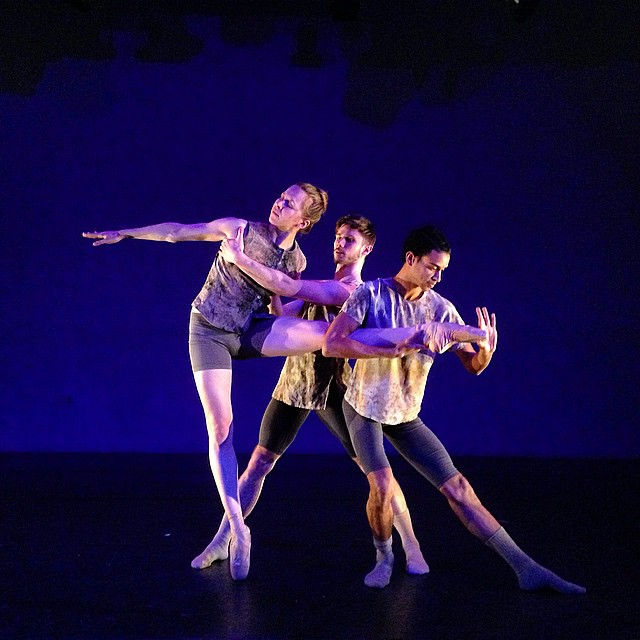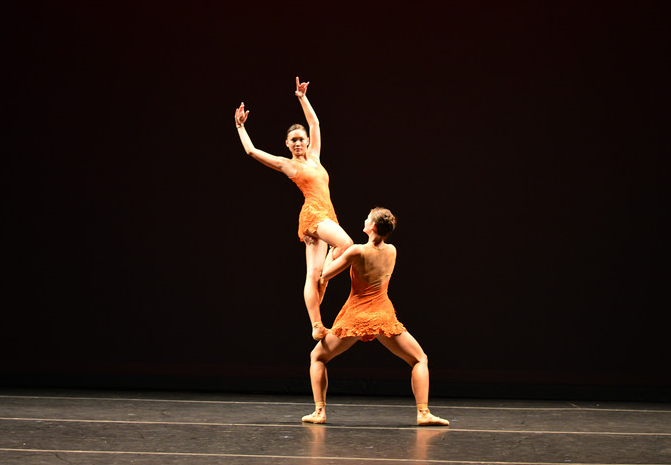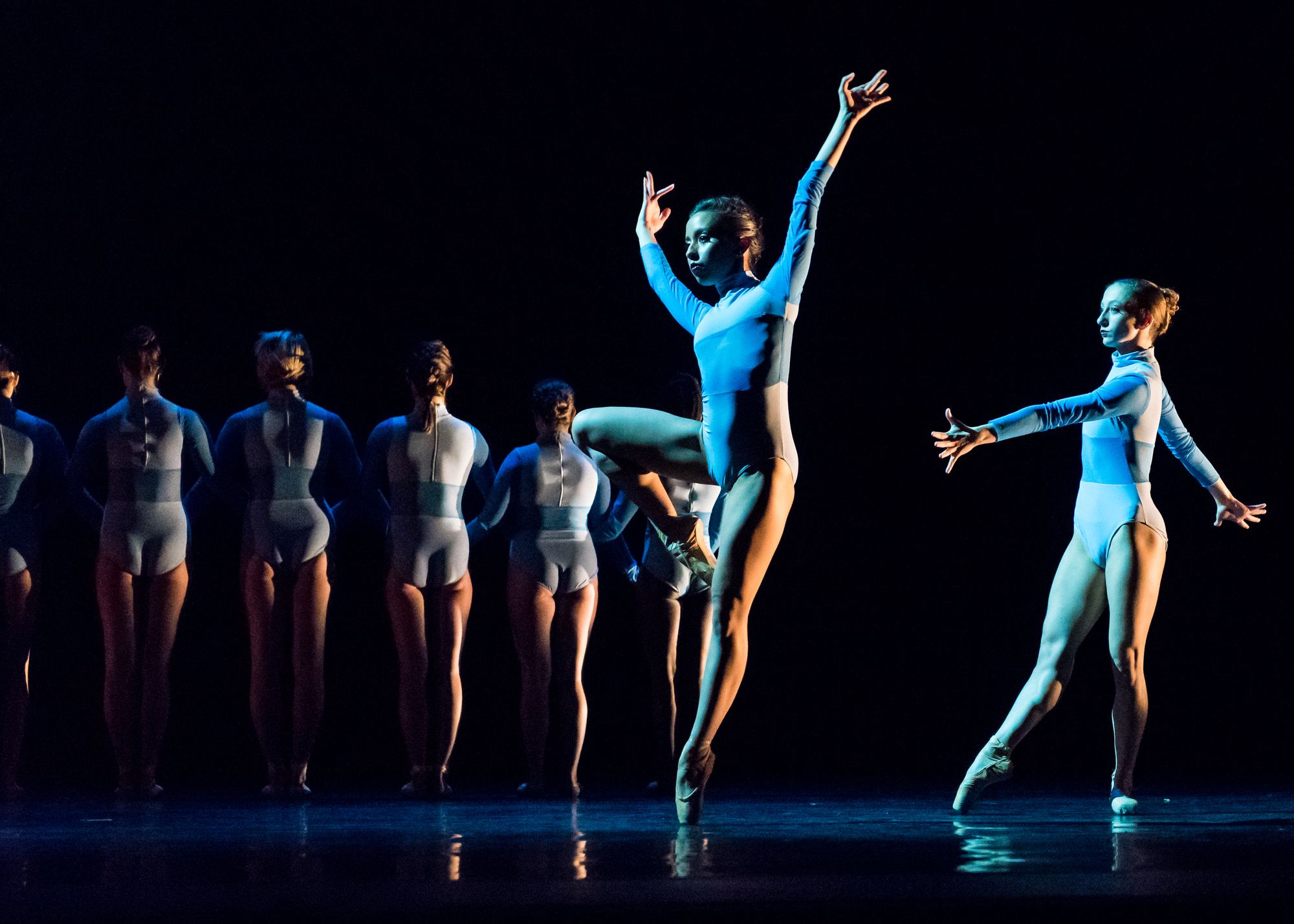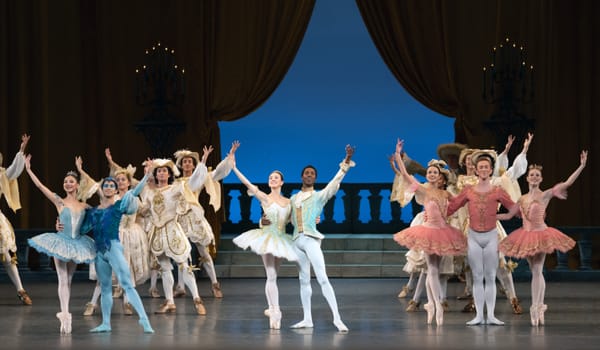Girl Talk

“Intermezzo,” “run-on sentences of I miss you…,” “Salutations,” “World’s Joy,” “Anodynia,” “Quill/t,” “losing farther, losing faster,” “Through the Dust,” “Portrait,” “NOUVEAU”
CounterPointe3 Festival
The Actors Fund Arts Center
Brooklyn, NY
April 11, 2015
An evening of ten works by female choreographers almost exclusively for women is bound to be illuminating; the question is of what, and to what extent. In this third annual installment, Julia Gleich's CounterPointe festival, an important and greatly fascinating endeavor where women create works for pointe and populate the male-dominated landscape of choreography with their own pieces, showed that while some of these mostly young dance makers were still just feeling their way through their craft, there was definitely a there there.
Amidst some innovative approaches to movement and content in most of the works, the pieces that actually showed the most depth and new perspective were the simpler ones that focused on these women’s more intimate presentation of their gender. One such work, Kristin Draucker’s "Portrait," was particularly moving in the way its sole dancer, the lovely Sarah Atkins, painted the picture of her character’s identity to Edgar Meyer’s “Sliding Down” with her hands, covering her face and uncovering it, and then with her body too. Dressed in a simple black cocktail dress, the color of Atkins’s movement showed a broad range of intensity with tentative ronds de jambe par terre and protectively held arms close to her chest in the shier spots, and large ronds en l'air, grand battements and fearless arm reaches in more emotional and passionate sections. There was a distinct palette to this woman in black that was shown in a revelatory, intimate way that seemed to delve deep into her personhood. As she faced away from the audience, grasped her head in regret but then turned to make revealing gesture uncovering her face and ended the work in silence she said even more.
Equally powerful in its own way was the night’s opening work, “Intermezzo,” by CounterPointe’s producer Julia Gleich. The piece, a trio for two men and one woman, was set to Johannes Brahms’s music played live on the piano by Elizabeth Myers, and was a slow display of deconstructed classical steps allowing the bodies of the three dancers to freely flow through the three dimensions of the stage. The dancers did not connect emotionally, but physically found themselves in contact time and time again. As Izabela Szylinska moved through the stage, her interactions with the men happened organically, as they would appear to provide support for her body with their bodies, sometimes one at a time, sometimes together, as with one promenade where one of the men supported her hands and the other her leg in arabesque. There was a complementary nature to their interactions which seemed to be borne not from conscious intent or necessity, but organic flow of their existence. The work was not said to be about gender relations, but although she was outnumbered, the work seemed largely about the female in the piece, and her equal place (underscored by the fact that all three dancers wore the same costumes of simple tops and tight grey shorts) as an equal and necessary part of the dancers’ ecosystem.

Another work deserving special mention was the second piece of the night, a work in progress titled “run on sentences of I miss you…” which was choreo- graphed and performed by Kayla Harley to music from the soundtrack to the film “Car Wash” and Nina Simone’s “I Get Along Without You.” Harvey tapped into the concealed inner world of a woman which may not be queried as she goes through her daily life, particularly by the men who may be attracted to her, but which can be full of complex emotions of loss, nostalgia and solitude. The piece began with Harley, in a skimpy dress covered by a big coat walking along the stage on pointe to a sound of cat calls. The men in the recording were clearly interested, but Harley was in her own world. As the spoken track gave way to music and Harley shed her protective coat, the dancer delved into a melancholy set of bourrées, seated poses and adjustments. Harley appeared to be lost in her thoughts, trying to find the right place in the world she inhabited, sitting, then adjusting the position, then rotating to have the pose face the back, but never coming to terms with her reality or finding herself at ease. By no means was the piece perfect, and the many repetitions and space-fillers in the steps should certainly be done away with, but Harley nonetheless is on the right track in presenting a look inside a woman’s psyche, and if she stays the course, the finished product is likely to be one worth waiting for.
Another look at a woman’s identity, and also a work in progress with moving sections that showed promise, was “losing farther, losing faster,” a work by Mishi Castroverde of mishiDance, set to the adagio from Ludwig van Beethoven’s Piano Sonata No.8. The music was overlaid with a recording of Elizabeth Bishop’s poem “One Art,” which added a dimension to the dance, performed by Debra Bona, as the choreography alternatively connected to the emotional load of the music and the poetry, never allowing you to fully lose hold of either part of the accompaniment, and letting both strands fill in the steps. One could read the phrasings, and read through them as the dancer would pause, turn away explore the tension in the music or the poetry, all with mostly classical movements. To end the melancholy, meditative piece, Bona took the dress and the pointe shoes off and walked off-stage, ending the telling, or the story as a whole.
Content aside and speaking strictly visually, Julia Gleich’s and Lynn Parkerson’s "Quill/t" was the most creative of the works, largely thanks to its projection of video footage and integration of the dancing with it. Throughout the ballet, the video on the back of the stage showed a writer writing the word "Quilt" in different forms, first all abstractly, such that the words created a scribbled mess, then more carefully and linearly, with more calligraphic attunement. As projected writing weaved a quilt from the overlaying of the words, four dancers took on different positions, and matched the different styles of writing with alternating formalism in their shapes, all through movement inspired by mathematical vectors.
The rest of the works were less remarkable, but probably could have read better off of more in-shape dancers. Donna Salgado’s “Salutations” to Yo-Yo Ma’s recorded performance of Bach selections presented three women alternating classical dance with decomposition of classical movement structure to more relaxed movements, such as we periodic shaking off of the dance’s formalism in the shoulders and upper body; but with Bach as its backbone the work should have said more. The excerpt from Sheena Annalise's "World's Joy" to original music by Sean Clements introduced some interesting female partnering, particularly in lifts and supports. Unfortunately, with most heavy lifting falling on the taller girl, it was difficult to view this as innovation rather than a necessary placement of a woman as a man's surrogate.

Eryn Renee Young’s futuristic looking "Anodynia" was intended to explore the strength and weaknesses of the female condition, and had a discernible primal quality to it. Yet the poorly fitted skirted-leotard costumes on the less-than-fit dancers took away from the full impact that the piece's dramatic pauses and distorted positioning could have achieved with more athletic and controlled performance. Jen McGinn’s “Through the Dust,” set to an impressive array of music from Chopin to Daft Punk and Drake, was promising from the start, and its translation of hip-hop and jazz movements to pointe work had an air of freshness to it. Though again, the piece, performed by dancers that came in all shapes and sizes donning futuristic leotards, likely would have revealed more of itself with a different cast.
Finally, the night’s closing work in progress by Katie Rose McLaughlin titled "NOUVEAU” sought to combine 80s style, Keds included, with pointe work to 80s-themed accompaniment. The pieces was repetitive, and the dancing, consisting of two female dancers who started out in Keds, but with one transitioning to pointe later, neither clashed with, nor complemented, the two styles. Perhaps the piece could have showed how to a dancer dancing is dancing, regardless of form or style, but the piece missed that opportunity and hopefully in its completion would find a way to capitalize on that spirit.
Surely not all of the works presented as part of CounterPointe3 were memorable, and some looked like raw and largely like experimental, exploratory creations. But by and large the project as a whole, if not all of its individual works, was worthy of loud applause.
copyright © 2015 by Marianne Adams



